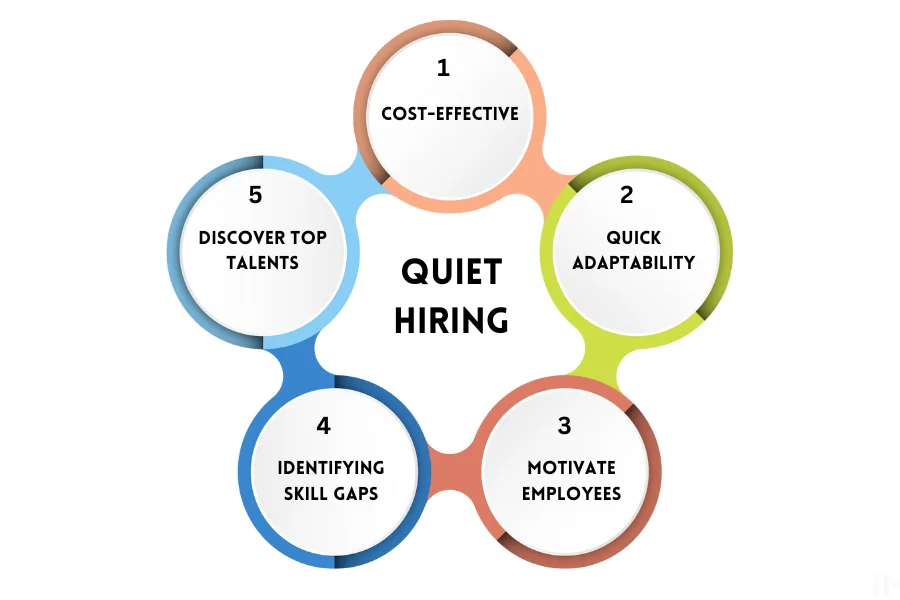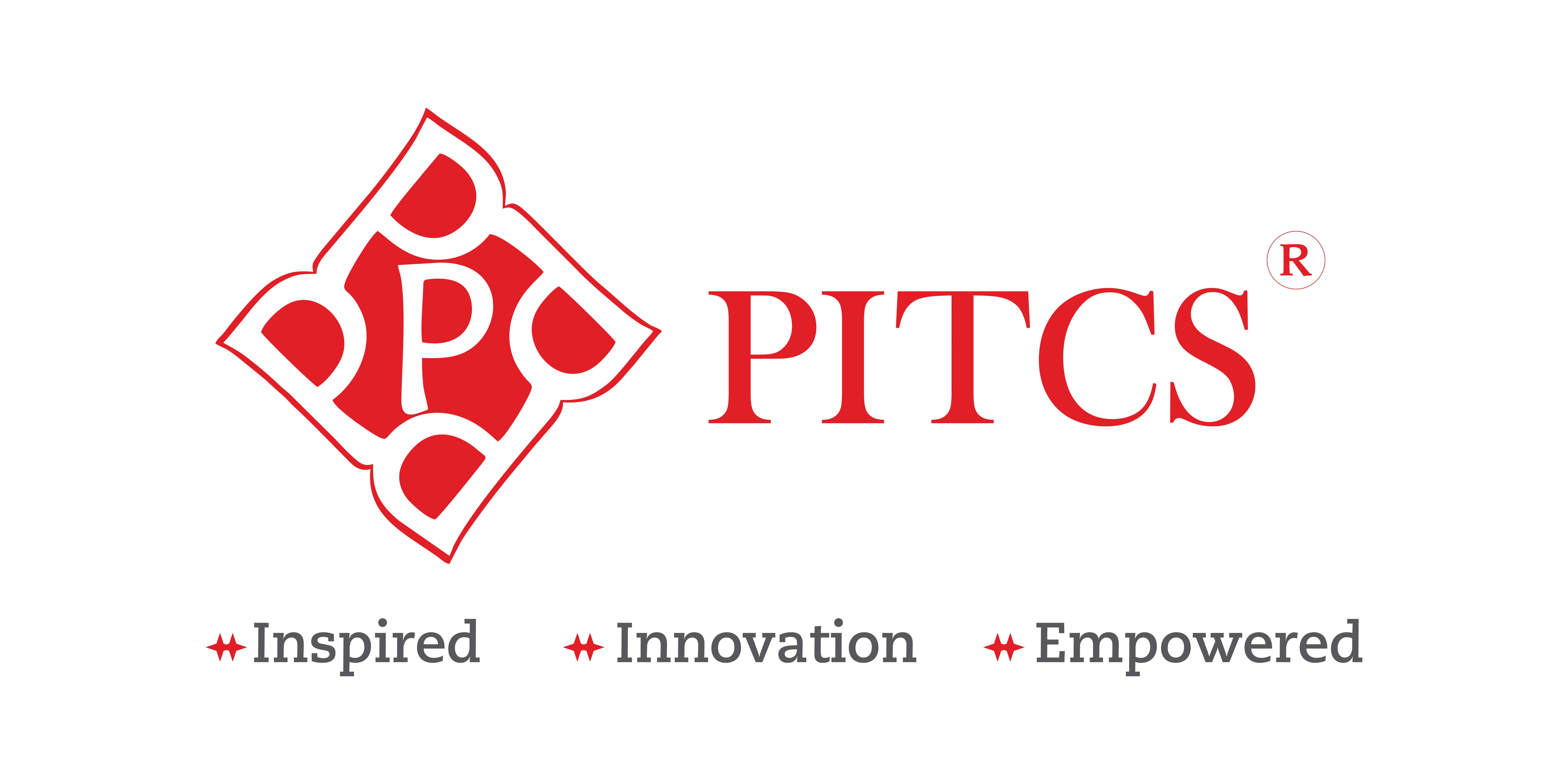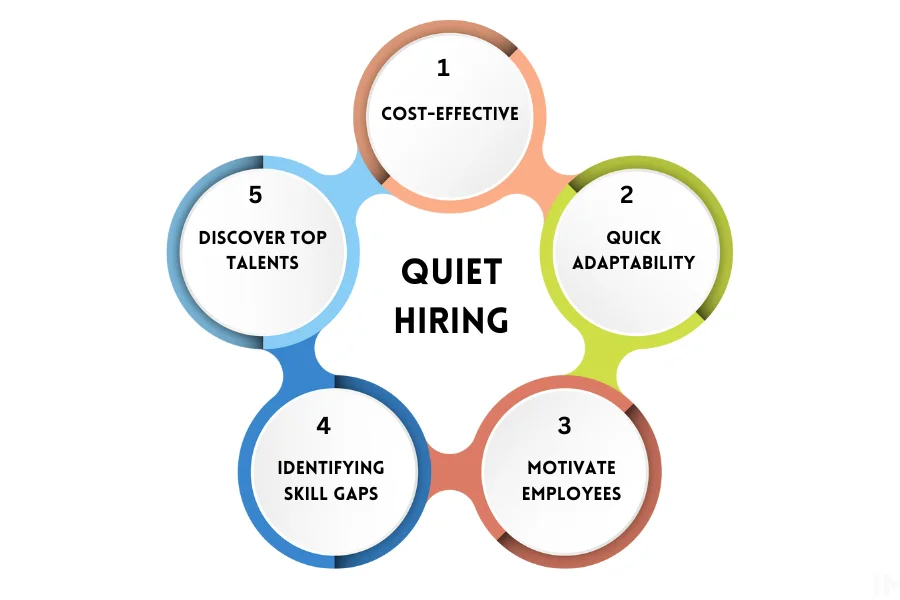Forget the flashy “Help Wanted” signs! The latest buzz in human resources isn’t about a hiring frenzy, but a quieter approach: quiet hiring. This strategy focuses on filling skill gaps and addressing needs within a company without the usual external hunt for new employees. Instead, companies turn to their existing talent pool or utilize temporary workers. But is quiet hiring a win-win, or are there hidden downsides?
Let’s explore quiet hiring, digging into its advantages, disadvantages, and what it means for both companies and their employees.
Table of Contents
What is Quiet Hiring?
Quiet hiring is acquiring new skills without directly increasing permanent staff. It encompasses utilizing temporary workers such as contractors, freelancers, or gig workers, but primarily involves leveraging existing employees to address skill deficiencies within the organization.
This can involve:
- Upskilling existing employees: Companies invest in training current staff to learn new skills relevant to the organization’s needs.
- Shifting responsibilities: Existing employees may take on additional tasks or projects, sometimes outside their usual areas, to fill gaps.
- Temporary workers: Companies might bring in freelancers, contractors, or gig workers for specific projects or short-term needs.
This approach contrasts with silent quitting, where employees do only their minimal job duties. Quiet hiring aims to keep employees engaged and develop their abilities, while silent quitting reflects employee disengagement.
Forms of Quiet Hiring:
There are two types of quiet hiring applied by human resource team for better result:
Internal Quiet Hiring:
In this form, current employees might temporarily move to other roles or take on different assignments within the organization.
Essentially, it’s about reshuffling existing talent to address changing needs.
External Quiet Hiring:
Here, organizations hire short-term contractors or freelancers to meet specific requirements.
The goal is to keep the business running without committing to additional full-time employees.

Advantages of Quite Hiring
In today’s dynamic business landscape, companies constantly seek innovative ways to address skill gaps and stay competitive. Quiet hiring, a strategic approach that utilizes existing talent or temporary workers, has emerged as a popular solution. This method offers several advantages, making it a valuable tool for businesses looking to optimize their workforce and achieve success.
Here are some advantages of quiet hiring:
- Cost-Effective: Quiet hiring saves money! Instead of spending time and resources on recruiting and training new staff, companies can leverage existing employees’ skills to fill gaps. This is a much faster and cheaper way to address short-term needs.
- Flexibility and Adaptability: Quiet hiring allows companies to quickly adjust to changing needs. By upskilling current employees and giving them new challenges, companies have a readily available pool of talent to adapt to new projects or situations. This flexibility can also boost employee morale and engagement.
- Motivation for Employees: Feeling stuck in a rut? Quiet hiring can be a great way for employees to break the monotony and learn new skills. Taking on additional responsibilities or projects can be a chance to test themselves and explore new career paths within the company.
- Identifying Skill Gaps and Managing Talent: Quiet hiring, combined with performance evaluations, can be a powerful tool for identifying areas where the team might lack specific skills. This allows companies to address those gaps through targeted training or by bringing in temporary workers for specialized tasks. Regularly monitoring employee performance can also help identify potential burnout or demotivation early on.
- Spotting Top Talent: Quiet hiring can be used alongside “talent mapping” to identify high-potential employees. By analyzing existing staff and their capabilities, companies can find individuals who are not only skilled but also willing to take on new responsibilities and challenges. This allows them to develop these “star employees” for future leadership roles within the organization.
Disadvantages of Quiet Hiring
- Limited Diversity: Quiet hiring can lead to a lack of fresh perspectives and experiences in the company. By focusing only on internal talent, companies might miss out on hiring people with new ideas and skills from outside the organization.
- Increased Stress and Burnout: When companies rely on quiet hiring to fill skill gaps, existing employees often end up with more work than they can comfortably handle. This can lead to increased stress, burnout, and ultimately, decreased productivity.
- Demotivation and Unhappiness: Employees who are constantly overloaded without additional compensation or recognition can become demotivated and unhappy. This can lead to a decline in morale and a higher turnover rate.
- Damaged Trust and Commitment: If companies rely on quiet hiring as a sneaky way to avoid hiring new staff, it can damage trust and commitment with employees. Feeling constantly overloaded with tasks outside their expertise can lead employees to feel undervalued and disengaged.

What to Consider as an Employee Facing Quiet Hiring?
If you suspect your company is using quiet hiring, here are some tips to navigate the situation:
- Be Assertive: Communicate your workload and capacity honestly. Express your limits and capabilities clearly, focusing on achieving departmental goals while prioritizing tasks effectively.
- Negotiate: If you’re taking on a heavier workload or learning new skills, talk to your manager. Discuss prioritizing tasks for departmental success. While a salary increase might not be possible, consider negotiating other benefits like flexible work arrangements or professional development opportunities.
- Self-Assess: Evaluate your own skills and knowledge. Propose a self-assessment with your manager to identify your strengths and weaknesses in relation to the new tasks. If they’re hesitant, do a self-evaluation yourself. Be clear about areas you excel in and those needing improvement.
By being assertive, advocating for yourself, and realistically evaluating your capabilities, you can manage the impact of quiet hiring on your workload and career development.
Conclusion: Finding Balance with Quiet Hiring
Quiet hiring can be a valuable tool, but it’s important to use it strategically. Here’s the key takeaway:
There’s no one-size-fits-all approach. Every situation, employee, and company culture has unique needs.
Before resorting to quiet hiring, consider:
- Can you hire strategically to fill specific skill gaps?
- Are there ways to streamline existing workflows to improve efficiency?
If quiet hiring becomes necessary:
- Communicate openly: Be transparent with employees about the reasons behind quiet hiring and the expectations involved.
- Invest in development: Provide training and support for employees taking on new responsibilities.
- Recognize and reward: Acknowledge and compensate employees for their additional efforts.
By prioritizing clear communication, employee development, and fair compensation, companies can leverage quiet hiring effectively while maintaining a positive and productive work environment. Also quiet hiring is in HR trend for better performance and survival strategy to grow in an economic volatile situation.


![Read more about the article 6 Amazing Recruitment Process Outsourcing Benefits [RPO]](https://pitcs.in/wp-content/uploads/2022/02/1-300x169.png)

![Read more about the article Mastering the Interview: How to Impress Recruiters [Expert Advice]](https://pitcs.in/wp-content/uploads/2024/02/Prepare-well-for-the-Interview-300x200.png)